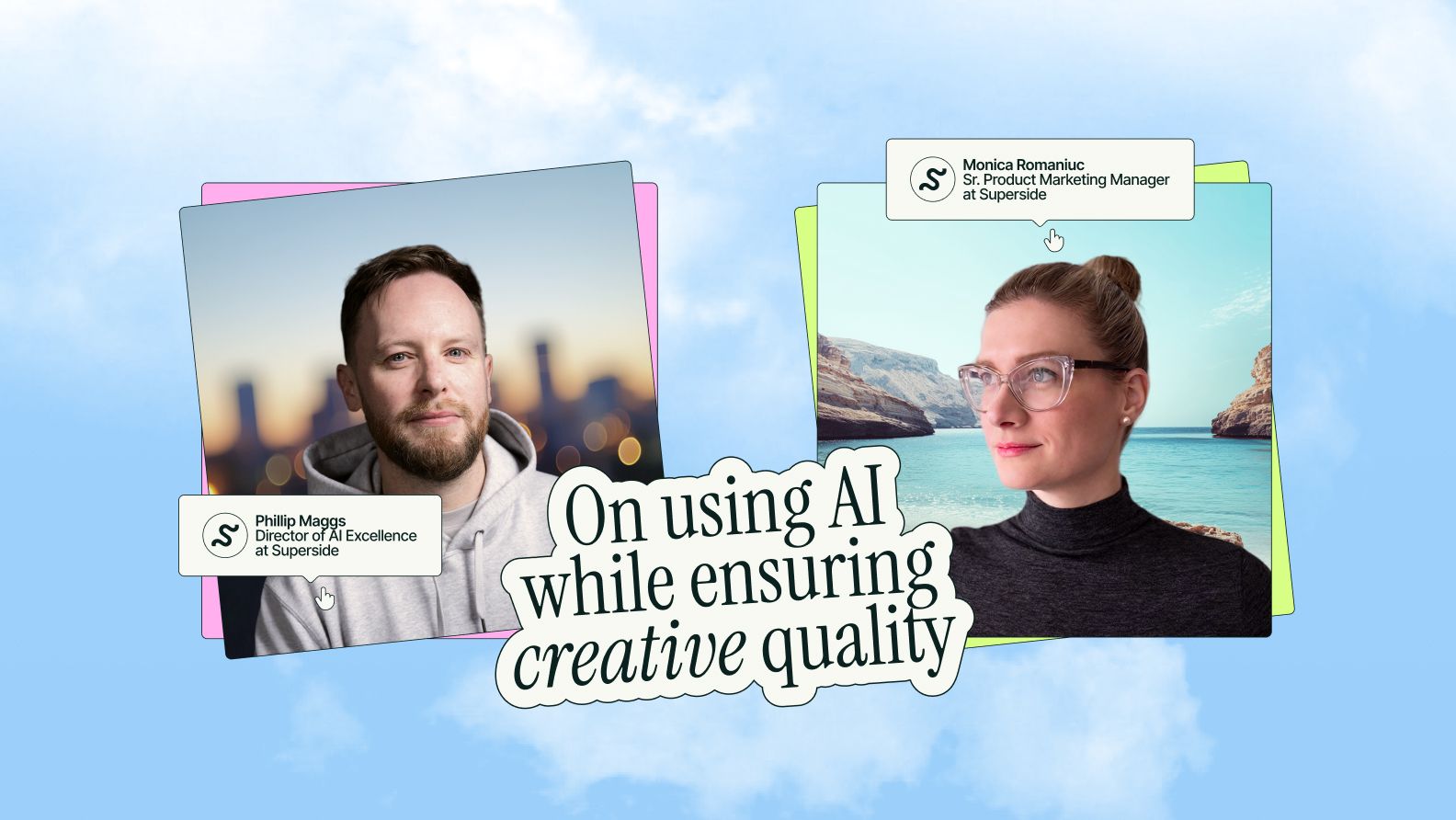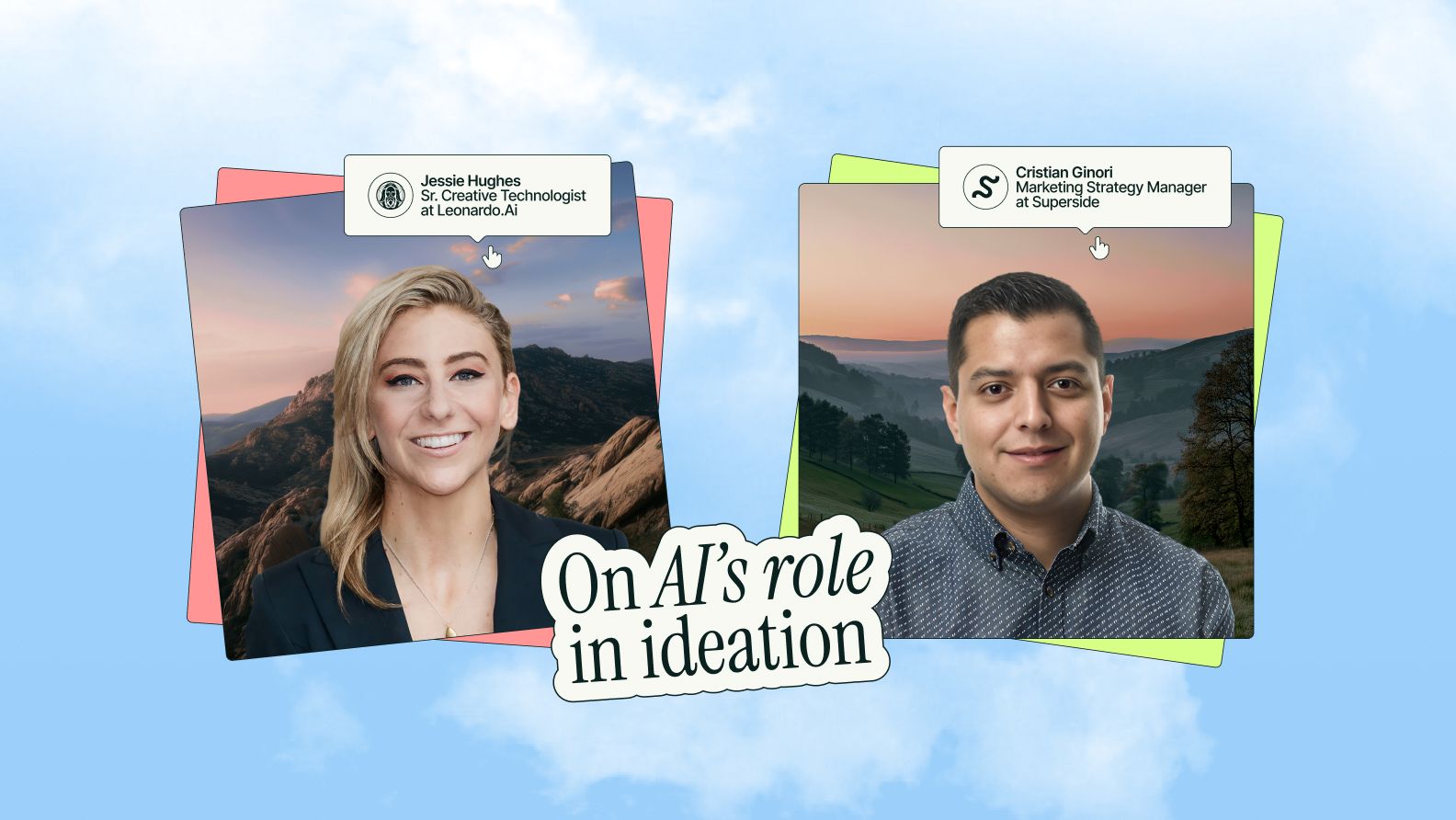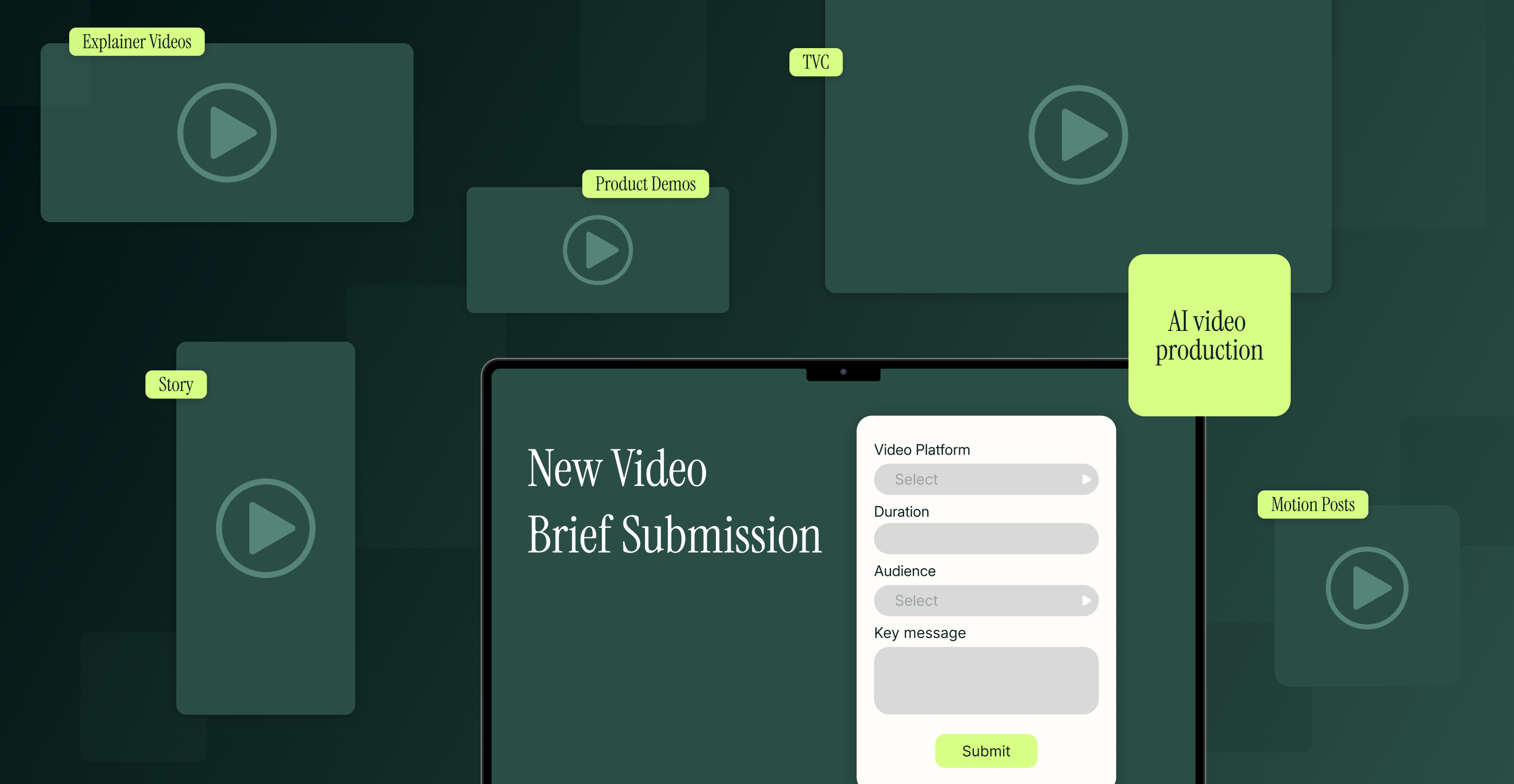A 7-Step Change Management Process for AI in Creative & Marketing

Friction is the current norm in AI integration, but it doesn't have to be. In this article, Captivate's Darren Chiu and Ben Wise share their 7-step framework for overcoming the biggest roadblocks to AI's adoption—human emotion. Learn how to use human psychology to bring your marketing and creative teams on board with the new tools and position your brand to scale.
You can’t shove a tuba in someone’s face and expect a symphony. Not a decent symphony, at least.
It’s how many creative and marketing teams approach AI integration: They're so focused on the lure of the result that they neglect the lengthy, grueling, rewarding learning period that builds the bedrock for all future symphonies. Under this too-common model, the best AI has to offer escapes everyone involved. People need direction, time and empathy from their leaders to make the switch.
At The Infinite Canvas, our AI marketing and design summit, Captivate's Darren Chiu and Ben Wise shared their insights on how marketing and creative leaders can manage this transition. Here’s Chiu and Wise’s framework for an AI change management process that all marketing and creative leaders can follow.
Step 1: Understand the Human Element
AI integration isn’t so much about the tech as it is the people soon to wield it. It’s not an easy route for anyone—our own CEO, who hosted the session, hinted at his own challenges in bringing it on board.
It took us a lot of thinking to get there, and we made lots of mistakes and good decisions along the way.

Recognizing that human concerns and emotions play a critical role in the adoption of new technologies is the first step. Employees may fear job security, feel confused about new tools, or be skeptical about AI's use cases. Addressing these concerns openly and empathetically can pave the way for smoother transitions. Understanding eNPS meaning (Employee Net Promoter Score) can further help organizations gauge employee sentiment during such transitions, ensuring that the integration process considers and addresses workforce morale.It's therapy without the comfy couch.
Read more generative AI statistics in marketing and creative to keep yourself equipped for the road ahead.
Step 2: Direct the Rider
Wise introduced the analogy of an elephant and a rider to explain how the human brain approaches change. The rider represents the rational side of the brain, while the elephant embodies the emotional side. “The rider is the rational side. It deliberates and considers facts and logic. The elephant, on the other hand, makes quick decisions based on intuition and gut instinct,” Wise explained.
Up to 90% of any given decision comes down to the emotional side, to that elephant.

Script your critical moves
Chiu emphasized the importance of clear direction. “You have to provide a clear direction and destination,” he said. To do this, leaders should:
- Identify bottlenecks: Determine what obstacles are preventing progress. This might include outdated processes, lack of training, or resistance from key team members. By pinpointing these issues, leaders can develop targeted strategies to overcome them. It’s Whac-A-Mole with fewer prizes.
- Create manageable steps: Break down the lofty goals into smaller, achievable tasks. For instance, instead of aiming to overhaul the entire marketing strategy with AI, start with a pilot project focusing on one aspect, such as automating customer segmentation.
- Give clear instructions: Ensure everyone knows exactly what to do and how to do it. Providing detailed guides, conducting training sessions, and offering continuous support can help team members feel more confident and capable. Think IKEA instructions, but hopefully less confusing.
You're the rider. What do we want to know as a rider? You want to know the GPS. You want to know where you're going and how to get there.

For a big boost in the operational department, clone yourself with AI.
Step 3: Motivate the Elephant
To motivate the emotional side of the brain, Wise suggested focusing on positive emotions and the concept of self-perception priming.
Foster positive emotions
“Negative emotions are effective at driving short-term actions, but for long-term change, you need to focus on positive emotions like excitement, intrigue, and hope,” Wise noted. Marketing and creative leaders can foster these emotions by highlighting the benefits of AI, such as increased efficiency, the potential for more creative work, and staying ahead of industry trends.
Prime peoples' identities by calling them the company’s AI innovators.

Prime positive self-perception
This involves exposing team members to stimuli that influence their self-perception positively. Recognizing and rewarding early adopters can create a positive feedback loop, encouraging others to follow suit.
Overcoming human barriers to AI integration is no easy feat. When you’ve got clear goals and a roadmap in mind, learn how to promote AI adoption on creative teams.
Step 4: Shape the Path
Creating an environment conducive to change is crucial, according to Chiu. “Environmental tweaks beat self-control every time,” he said.
Create the right environment
Ensure the desired behavior is the default behavior. This can be achieved by:
- Remove distractions: Simplify the environment to focus on the new processes. This could involve redesigning workspaces to minimize interruptions, providing dedicated times for learning new tools, or streamlining workflows to integrate AI seamlessly.
- Upgrade automatically: Implement updates that make old processes obsolete. Automatically upgrading software to include AI features can help ease the transition by removing the option to revert to previous methods. It's the annoying software update that keeps popping up— but this time it's actually helpful.
- Ensure access to support: Provide easy access to help and resources. This might include setting up a helpdesk for AI-related queries, creating a knowledge base, or organizing regular Q&A sessions with AI experts.
Discipline and self-control are exhaustible resources. Without shaping that path, it's very tiring for the rider to constantly control the elephant through an obstacle course.

Other creative and marketing leaders weighed in to offer more expert AI tips. Check them out for some refreshing, nuanced takes on how you can use these tools in your own processes and strategies.
Rally the herd
Leverage the psychology of social proof by gathering like-minded individuals to create a sense of trust and community. “Find your herd, strengthen your community, and use the power of social proof to grow your movement,” Chiu advised. Leaders can identify and empower champions within the team who can advocate for AI, share success stories, and support their peers. It’s basically high school all over again, but with less acne and more AI.
Step 5: Practice Application
Thomassen aaddressed the importance of leadership in driving AI adoption. “Leaders need to set the tone on a culture of sharing success stories and promoting experimentation,” he said.
Thomassen added, “We talk to hundreds of startups and enterprise companies every single month on these topics. It’s pretty much all we do.”
Share success stories
Highlighting successful AI projects within the organization can help build momentum and demonstrate tangible benefits. This could involve presenting case studies during team meetings, publishing internal newsletters, or showcasing achievements on company intranets.
Promote experimentation
Encourage a culture of experimentation where team members feel safe to try new things and learn from failures.
Generative AI is still so new that beyond the projects you're working on, your people are just going to come up with other things to use it for.

Leaders should provide opportunities for employees to experiment with AI, such as hackathons, innovation labs, or sandbox environments. It's a playground, with fewer monkey bars and more data sets.
Step 6: Address Resistance
Resistance to change is natural, and it’s crucial to handle it with sensitivity and strategic planning.
There’s a difference between people asking questions and people being resistant to change. We have to appeal to that.

Chiu elaborated, “Look for language like, ‘We've always done it this way,’ or, ‘If it's not broken, don’t fix it,’ or, ‘It’s faster if I just do it myself.’ These can be signs of resistance to the tools.”
Listen and address concerns
Create open channels for feedback where employees can voice their concerns without fear of retribution. Conducting anonymous surveys, holding town hall meetings, and having one-on-one check-ins can provide valuable insights into the sources of resistance.
Educate and reassure
Educate team members about AI's benefits and dispel myths that may be causing fear. “People are really afraid about the impact of AI on their jobs. I think some level of reassurance that they can give or as much as they can give is crucial,” Thomassen emphasized. Highlighting how AI can enhance rather than replace human creativity can help alleviate fears.
Setting the tone on a culture of sharing success stories and promoting experimentation can help build trust and reduce resistance.

Team members may have loads of questions about AI, so be prepared to field them.
Step 7: Build a Supportive Culture
A supportive culture is the bedrock of successful AI integration. Wise noted the importance of a “culture of sharing success stories and promoting experimentation.”
Create a shared vision
Leaders should articulate a clear vision for AI adoption, linking it to the organization’s broader goals. This vision should be communicated regularly through various channels like team wiki to ensure alignment and buy-in from all team members.
Create an environment where the desired behavior is the default behavior.

Celebrate milestones
Celebrate both small wins and major achievements to maintain motivation and enthusiasm. Whether it’s a team lunch, a shoutout in a company-wide email, or a more formal recognition program, celebrating progress keeps morale high and reinforces positive behaviors. If you’ve learned how to create ad creative with AI reliably, it deserves recognition.
Put Humanity First to Integrate AI
Integrating AI into creative and marketing teams requires a thoughtful approach that addresses both the technical and human aspects. By understanding the human element, directing the rider, motivating the elephant, shaping the path, sharing success stories, promoting experimentation, addressing resistance, and building a supportive culture, leaders can navigate the complexities of AI adoption effectively.
As Wise noted, “The use of artificial intelligence cannot be done without emotional intelligence.” This framework, grounded in psychological insights and practical steps, offers a roadmap for creative and marketing leaders to follow. By understanding and addressing the human challenges, teams can embrace these tools and unlock AI’s full potential—as well as their own.
If you're curious to figure out your own AI strategy, or if you have concerns about how to deploy it, which tools to choose, reach out to us!

Now, go forth and conquer your world. One newly-assured team member at a time.
David is a Senior Content Marketer at Superside. A former journalist with bylines too numerous to enumerate, he brings his love of storytelling and semantics to the marketing world. Recognizing the sizable gaps in the creative-as-a-service (CaaS) sector, he jumped at the chance to fill the creative void for ambitious brands. In his off hours, he enjoys loud music, making vegan meals and being made fun of for making vegan meals. He’ll gladly talk to you about any of the above on LinkedIn.
You may also like these

AI meets expertise: Inside Superside’s formula for quality creative
Will it look too “AI-y?” Will it sound too “AI-y?”When it comes to AI, many creatives and marketers share a common concern: Will it compromise the quality of their work?In our latest guide, Inside Great Creative Partnerships, Superside’s Phillip Maggs, Director of AI Excellence, and Monica Romaniuc, Senior Product Marketing Manager, confirmed this fear is unfounded—provided you’re doing it right. From quick tips to caveats, they shared:Where AI can provide value across creative and marketing workflowsWhy legacy stacks are a caveat (but not a lost cause)
Ideating with AI: Inside a creative vs. marketing workflow
When generative AI gives you an eagle with two skateboards, lean in. When it gives you 10 angles for a campaign, choose wisely.In the ideation phase of her design workflow, Jessie Hughes, Senior Creative Technologist at Leonardo.Ai, embraces AI—accidents and all—to fuel greater creativity. By contrast, Cristian Ginori, Marketing Strategy Manager at Superside, takes a structured approach to brainstorming with AI, using systems to guide creativity toward strategic outcomes.Superside’s latest guide, Inside Great Creative Partnerships, digs into both approaches—and how AI helps creatives and marketers meet in the middle. Get a sneak peek of these insights, including:Why turning up the volume breeds better resultsHow to riff, refine and systematize with AI
7 best AI video studios for large-scale creative
When AI tools like ChatGPT and Midjourney first launched in 2022, they were little more than a novelty. But within a few months, AI usage surged across fields such as programming and marketing, with enterprise brands leading the charge.Video production has seen some of the most exciting developments in generative AI. Not so long ago, it was almost impossible to produce realistic-looking AI videos. Today, with the right creative direction and strong human oversight, it’s a fully viable production method.The fact is, AI tools can generate good videos, but that alone won’t meet the high creative standards today’s top enterprise brands have already set. If your brand operates at this level, you need a video studio partner that deeply understands brand, scale, messaging and AI-driven precision.This guide reveals what AI video studios bring to the table and why they beat DIY tools for those who want to deliver top-quality creative at scale, with insights from Francesca Bocaranda, Video Producer at Superside. Stay tuned for a curated list of the best AI video agencies that’ll transform your video production capabilities.What AI video studios agencies actually do














